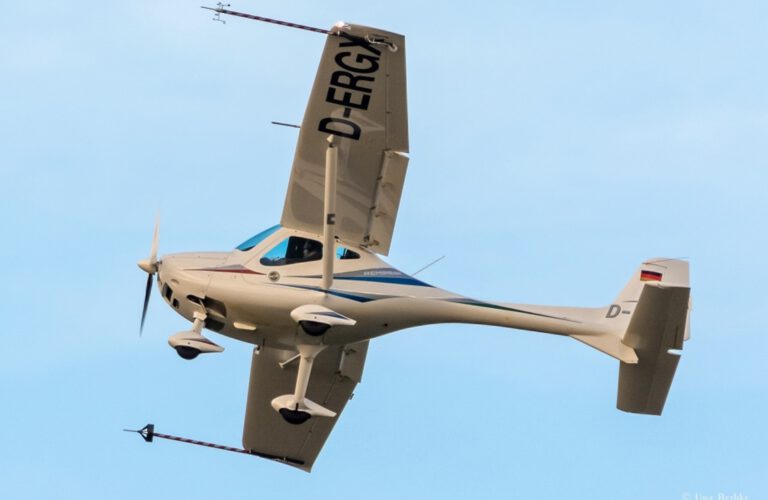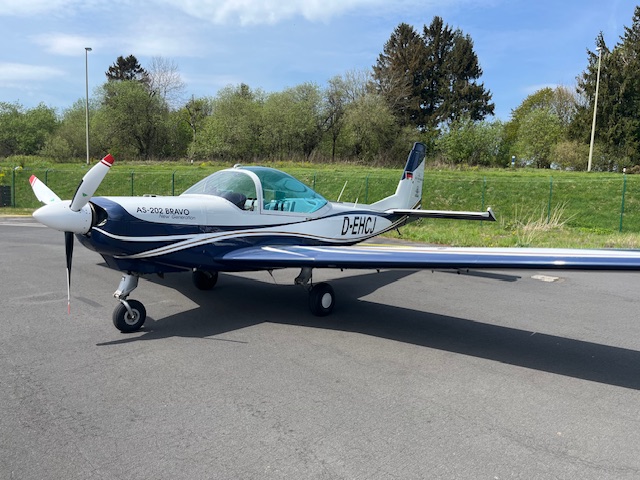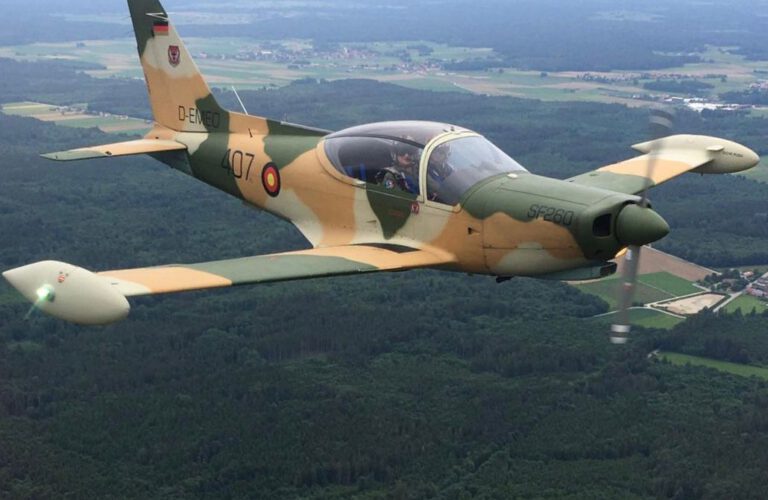Aircraft
The goal of flight test training is to enable the students to test-fly as many aircraft as possible including exotic non-standard configurations. This aircraft display is an extract of the basic training fleet. Additional aircraft types will be utilised on an as-need basis. All aircraft are equipped with a portable Flight Test Instrumentation System.
Remox GX
- MTOW: 600 kg
- v,ne: 134 kts / (250 km/h)
- Rate of Climb: 1250 ft/min (6,5 m/s)
- g-limits: +4/-2 g
- Powerplant: Rotax 912 ULS with 100 hp
- Seats: 2
The Remos GX is a LSA “Made in Germany”. Our aircraft is fully equipped with a permanent flight test instrumentation with real-time and post-flight analysis capability. Course participants can track and record more than 100 parameters including
- high-performance IMU (accelaration, attitude, angular velocity)
- control forces
- control surface deflections
- air data from 2 independant air data booms (alpha, beta, total pressure, static pressure)
- ambient temperature
- engine parameters
- DMS
- flutter
- event marker
- 100 Hz
Furthermore, the primary flight controls can be controlled through an experimental fly-by-wire system, which permits for variations in the stability and handling qualities of the aircraft. The servos can be easily disengaged at any time for safety reasons.
The high wing configuration allows for the quick installation of a variety of project-tailored underwing pods for sensor testing. The max. pod payload is around 10 kg and can be powered either by an additional generator or by battery.
A telemetry system is currently in development.
Blackshape Prime
- MTOW: 600 kg
- Cruise Speed: 151 kts / (280 km/h)
- Rate of Climb: 1150 ft/min (6 m/s)
- g-limits: +4/-2 g
- Powerplant: Rotax 912 with 100 hp
- Seats: 2
The Blackshape Prime is a fighter-like LSA in tandem configuration. The low wing configuration and the low fuselage cross-section combined to the carbon fiber structure ensure to the Blackshape Prime high performance combined to extraordinary agility. The core of its avionics package consists of a state-of-the-art Dynon Skyview, providing PFD and MFD capabilities in a compact 10” display in the front seat and 7″ in the back seat. An autopilot with altitude hold, heading hold and level function supplements the avionics system.
The Skyview provides data storage and USB/Wifi export of more than 100 flight and engine parameters.
AS202 Bravo NG
- MTOW: 1.080 kg
- Take-Off/Landing Distance: 200 m
- Passengers: 2+1
- Powerplant: Lycoming AEIO-360 with 180 hp
The Bravo as an ex-military trainer aircraft is our basic training asset. While its first flight was in 1969, the first NG took of in 2020. It features a new Garmin glass cockpit and is fully aerobatic.
Tiger Moth
- MTOW: 830 kg
- Service Ceiling: 4300 m
- Passengers: 1+1
- Powerplant: de Havilland Gipsy with 130 hp
The Tiger Moth was designed as a military trainer in the UK and had its first flight in 1931. This biplane was widely used in the Royal Air Force, so in the end more than 7000 aircraft were built and sold to around 40 military customers around the world.
Aermacchi SF-260 Warrior Libya
- MTOW: 1200 kg
- Max. Speed: 190 kts / (350 km/h)
- g-loads: +6g / -3g
- Powerplant: Lycoming O-540 with 260 hp
- Seats: 2
The SF-260 is an aerobatic aircraft designed as a trainer for fighters. Thus it has jet-like handling qualities and with its high power/weight ratio and the retractable gear it is one of the most agile piston aircraft on the market. In 1986 it was featured in an article of the Flying magazine as “the fastest singl-engine piston aircraft on the market currently in production”. Its controls around all 3 axes are precise and quick responsive.
Our SF-260 is an ex-Libyan Air Force aircraft, which has been demilitarized and registered as a regular Echo-class aircraft in Germany.
Extra 330 LX
- MTOW: 950 kg
- Cruise Speed: 165 kts / (305 km/h)
- Roll Rate: 420°/sec
- Powerplant: Lycoming AEIO-580-B1A with 315 hp
- Loads: +8/-8 g
- Seats: 2 (tandem)
The Extra 330 LX is a low-wing aerobatic monoplane with taildragger landing gear offering exceptional aerobatic performance.
Pilatus PC-12 NG
- MTOW: 4740 kg
- Cruise Speed: 270 kts / (500 km/h)
- Range: 1800 NM / (3300 km)
- Powerplant: Pratt Whitney PT6A-67P with 1200 hp
- Seats: 10
The PC-12 is a world-class turboprop passenger and cargo aircraft. It is the best-selling single-engine pressurized turbine-powered aircraft in the world used by both commercial and military operators (special operations and ISR).
L-39 Albatros
- MTOW: 4700 kg
- Cruise Speed: 480 kts / (900 km/h)
- Rate of Climb: 4300 ft/min (22 m/s)
- Ceiling: 37.700 ft (11.500 m)
- g-limits: +8/-4 g
- Powerplant: AI-25TL 1720 kg (3800 lbs) thrust twin-shaft turbofan jet engine
- Seats: 2
The Aero L-39 Albatros is a high-performance military jet training aircraft. More than 2.800 L-39 have been in service in Air Forces all over the world. In addition to performing basic and advanced pilot training it has also flown combat missions in a light-attack role. The L-39C has zero-height ejection seats for both front and back seat. The L-39 flight test training is provided in cooperation with the worldwide renowned Latvian aerobatic team of the Baltic Bees.
The L-39 is equipped with a portable Flight Test Instrumentation System suitable for in-flight display and post-flight analysis of the following parameters:
- GPS lat, long, altitude and baro altitude
- x, y, z velocities
- x, y, z accelerations
- roll, pitch, yaw angles and rates
- 3-axis mags
- control force sensors
The L-39 also constitutes an excellent airborne testbed. It carries 2 underwing pods which can be equipped with sensors ranging from EO/IR, RADAR , hyperspectral or other detectors. Specifications of the pods can be tailored to customer needs, payload weight per pod is around 150 kg, power supply around 500 W per pod. The pods are easily detachable (and even jettisonable) with standard locks.
FanJet 600
- MTOW: 1800 kg (de-militarized)
- Cruise Speed: 200 kts / (360 km/h) @ 1000ft
- Rate of Climb: 3150 ft/min (16 m/s)
- Ceiling: 25.000 ft (7.600 m)
- Powerplant: Allison 250 C30, 650 shp
- Seats: 2
The FanJet, also known as Fantrainer, is a Germany designed and built military trainer for jet pilots. The aircraft has jet like handling characteristics and has been fully certified. With its bypass fan engine positioned behind the rear cockpit the FanJet 600 will simulate the flight behavior of a basic jet aircraft and will make a significant handling difference to any turbo prop trainer in its class. The primary requirements were to create an entry level aircraft with low fuel consumption, low noise and low fuel emission with the handling qualities of a jet.
The cockpit ergonomics is excellent and the field of vision is as good as that in a jet. The pilot and co-pilot are seated in tandem. They have identical cockpits that can operate independently to simulate non flight safety critical system failures.
The FanJet is equipped with a portable Flight Test Instrumentation System suitable for in-flight display and post-flight analysis of the following parameters:
- GPS lat, long, altitude and baro altitude
- x, y, z velocities
- x, y, z accelerations
- roll, pitch, yaw angles and rates
- 3-axis mags
- control force sensors
S-211 Marchetti
- MTOW: 2750 kg (clean)
- Cruise Speed: 360 kts / (667 km/h)
- Rate of Climb: 4200 ft/min (21 m/s)
- Ceiling: 40.700 ft (12.200 m)
- g-limits: +6/-3 g
- Powerplant: Pratt & Whitney Canada JT-15D turbofan 11.12 kN (2500 lbs) thrust
- Seats: 2
The S-211 is a turbofan-powered military trainer developed by the Italian aircraft manufacturer SIAI-Marchetti. It has been sold to a variety of Air Forces worldwide, whereof Singapore was one of the largest customers. Our aircraft is a buy-back from Singapore as well. Its front and rear cockpits are fully duplicated, making it an excellent training aircraft. It comes with 2 hot ejection seats Martin Baker Mk10 0/70.
The S-211 is equipped with a portable Flight Test Instrumentation System suitable for in-flight display and post-flight analysis of the following parameters:
- GPS lat, long, altitude and baro altitude
- x, y, z velocities
- x, y, z accelerations
- roll, pitch, yaw angles and rates
- 3-axis mags
- control force sensors
The S-211 also constitutes an excellent airborne testbed. It can be equipped with 2 underwing pods sensors carriage, ranging from EO/IR, RADAR , hyperspectral or other detectors. Specifications of the pods can be tailored to customer needs.
Citation M2
- MTOW: 4800 kg
- Cruise Speed: 404 kts / (748 km/h)
- Rate of Climb: FL410 in 24 min
- Ceiling: 41.000 ft (12.500 m)
- Powerplant: Williams FJ44 with 8,74 kN ea (1965 lbs) thrust
- Seats: 6 (passengers)
The M2 is equipped with a portable Flight Test Instrumentation System suitable for in-flight display and post-flight analysis of the following parameters:
- GPS lat, long, altitude and baro altitude
- x, y, z velocities
- x, y, z accelerations
- roll, pitch, yaw angles and rates
- 3-axis mags
- control force sensors
EH-60A Black Hawk
Needless to present all the qualities of the Black Hawk. This iconic helicopter has been the backbone of the US Army and its allies airborne transport capability for more than 40 years. Over 4000 pieces have been produced in several variants. The predominant feature during its development was its resilience against firearms up to 23 mm while still fulfilling its mission. Even during the loss of main gear oil pressure, the Black Hawk can continue its flight for one hour. Another interesting feature is the spatial arrangement of the tail rotor, which is not entirely horizontal. Thus, it not only generates anti-torque but also contributes around 2.5% to the overall lift of the helicopter.
The EH-60A is a demilitarized version of the electronic warfare variant of the US Army.
- MTOW: 10,000 kg (22,000 lbs)
- SHP: 2 x 1500
- Engine: 2 x General Electric T700
- v,ne IAS: 350 km/h (190 kts)
Misc. Helicopters
We use a wide variety of different helicopter types for our flight test training, ranging from single-engine piston to multi-engine turbine.
- Bell 206 Jet Ranger
- Robinson R44
- Airbus Helicopters AS-350
- Airbus Helicopters AS-355
- Airbus Helicopters (Bölkow) Bo-105
- Airbus Helicopters EC-135
- Airbus Helicopters H-145
- MD 900 Explorer
- Sikorsky S-76
For our professional courses we cooperate with the German Aerospace Center (DLR) and have access to the one-of-a-kind EC-135 Variable Stability System. Picture of the EC-135 VSS courtesy of DLR.





















































































